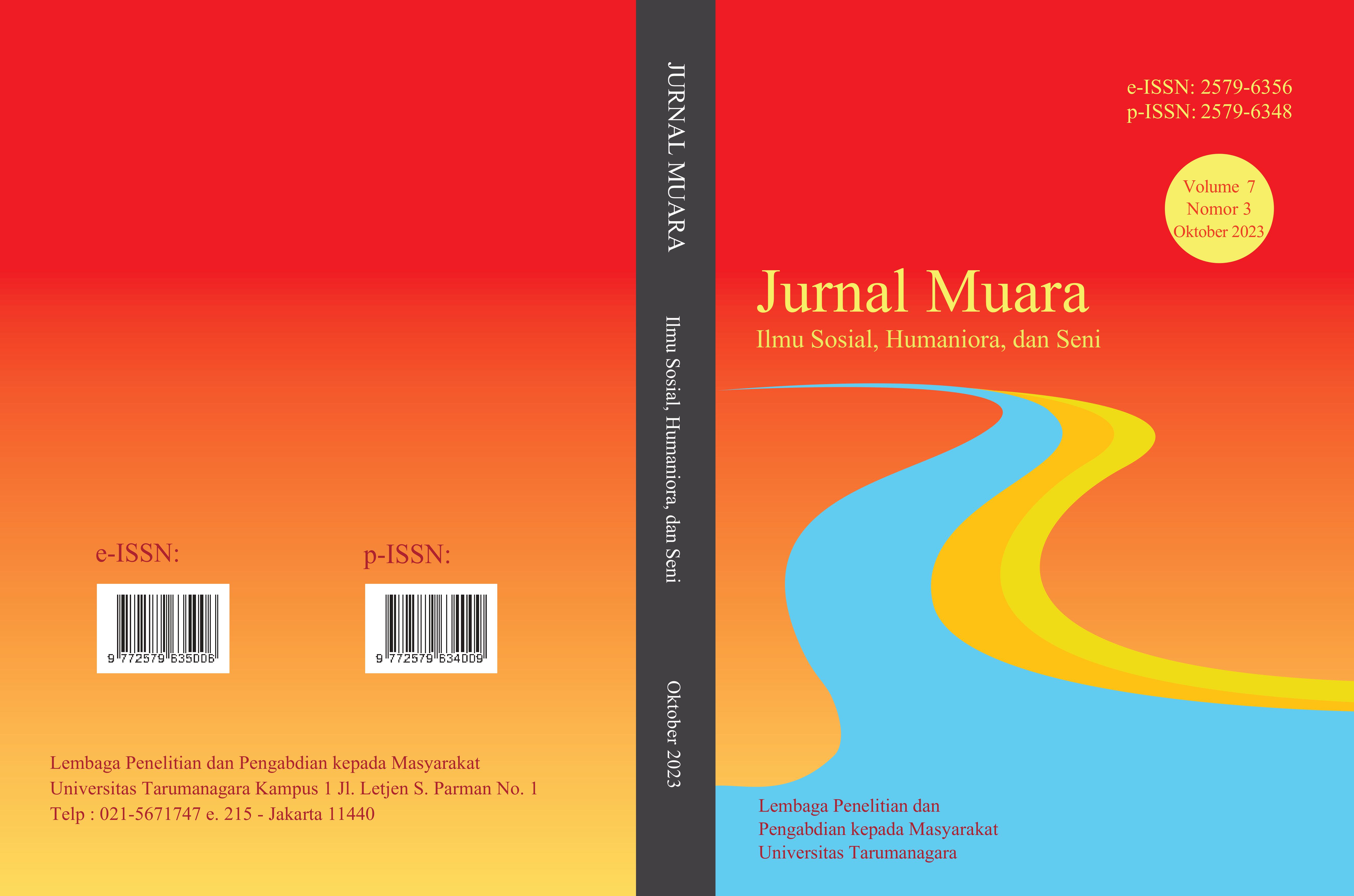TIDAK SELAMANYA KARYAWAN YANG DISIPLIN DAN TEKUN AKAN TETAP RAJIN (SAAT MENERIMA PERLAKUAN KASAR)
Main Article Content
Abstract
Article Details

This work is licensed under a Creative Commons Attribution-NonCommercial-ShareAlike 4.0 International License.
This work is licensed under a Jurnal Muara Ilmu Sosial, Humaniora, dan Seni Creative Commons Attribution-ShareAlike 4.0 International License.References
Andersson, L. M., & Pearson, C. M. (1999). Tit for tat? The spiraling effect of incivility in the workplace. Academy of Management Review, 24(3), 452-471. https://doi.org/10.2307/259136
Berry, C. M., Ones, D. S., & Sackett, P. R. (2007). Interpersonal deviance, organizational deviance, and their common correlates: A review and meta-analysis. Journal of Applied Psychology, 92(2), 410-424. https://doi.org/10.1037/0021-9010.92.2.410
Birkeland, I. K., & Nerstad, C. (2016). Incivility is (not) the very essence of love: Passion for work and incivility investigation. Journal of Occupational Health Psychology, 21(1), 77-90. https://doi.org/10.1037/a0039389
Connor-Smith, J. K., & Flachsbart, C. (2007). Relations between personality and coping: A meta-analysis. Journal of Personality and Social Psychology, 93(6), 1080-1107. https://doi.org/10.1037/0022-3514.93.6.1080
Cortina, L. M., & Magley, V. J. (2009). Patterns and profiles of response to incivility in the workplace. Journal of Occupational Health Psychology, 14(3), 272-288. https://doi.org/10.1037/a0014934
Cortina, L. M., Magley, V. J., Williams, J. H., & Langhout, R. D. (2001). Incivility in the workplace: Incidence and impact. Journal of Occupational Health Psychology, 6(1), 64-80. https://doi.org/10.1037/1076-8998.6.1.64
Dalal, R. S. (2005). A meta-analysis of the relationship between organizational citizenship behavior and counterproductive work behavior. Journal of Applied Psychology, 90(6), 1241-1255. https://doi.org/10.1037/0021-9010.90.6.1241
Dudley, N. M., Orvis, K. A., Lebiecki, J. E., & Cortina, J. M. (2006). A meta-analytic investigation of conscientiousness in the prediction of job performance: Examining the intercorrelations and the incremental validity of narrow traits. Journal of Applied Psychology, 91(1), 40-57. https://doi.org/10.1037/0021-9010.91.1.40
Fox, S., & Spector, P. E. (1999). A model of work frustration–aggression. Journal of Organizational Behavior, 20(6), 915-931. https://www.jstor.org/stable/3100373
Fox, S., Spector, P. E., & Miles, D. (2001). Counterproductive work behavior (CWB) in response to job stressors and organizational justice: Some mediator and moderator tests for autonomy and emotions. Journal of Vocational Behavior, 59(3), 291-309. https://doi.org/10.1006/jvbe.2001.1803
Gallus, J. A., Bunk, J. A., Matthews, R. A., Barnes-Farrell, J. L., & Magley, V. J. (2014). An eye for an eye? Exploring the relationship between workplace incivility experiences and perpretation. Journal of Occupational Health Psychology, 19(2), 143-154. https://doi.org/10.1037/a0035931
Griffin, R. W., O’Leary-Kelly, A., & Collins, J. M. (Eds.). (1998). Dysfunctional behavior in Organizations: Violent and deviant behavior. Elsevier Science/JAI Press.
Krischer, M. M., Penney, L. M., & Hunter, E. M. (2010). Can counterproductive work behaviors be productive? CWB as emotion-focused coping. Journal of Occupational Health Psychology, 15(2), 154-166. https://doi.org/10.1037/a0018349
Laschinger, H. K. S., Leiter, M., Day, A., & Gilin, D. (2009). Workplace empowerment, incivility, and burnout: Impact on staff nurse recruitment and retention outcomes. Journal of Nursing Management, 17(3), 302-311. https://doi.org/10.1111/j.1365-2834.2009.00999.x
Lazarus, R. S. (1991). Emotion and adaptation. Oxford University Press.
Lazarus, R. S., & Folkman, S. (1987). Transactional theory and research on emotions and coping. European Journal of Personality, 1(3, Spec Issue), 141-169. https://doi.org/10.1002/per.2410010304
Lim, S., Cortina, L. M., & Magley, V. J. (2008). Personal and workgroup incivility. Impact on work and health outcomes. Journal of Applied Psychology, 93(1), 95-107. https://doi.org/10.1037/0021-9010.93.1.95
Meier, L. L., & Spector P. E. (2013). Reciprocal effect of work stressor and counterproductive work behavior: A five-wave longitudinal study. Journal of Applied Psychology, 98(3), 529-539. https://doi.org/10.1037/a0031732
Miles, D. E., Borman, W. E., Spector, P. E., & Fox, S. (2002). Building an integrative model of extra role work behaviors: A comparison of counterproductive work behavior with organizational citizenship behavior. International Journal of Selection and Assessment, 10(1‐2), 51-57. https://doi.org/10.1111/1468-2389.00193
Neuman, W. L. (2014). Social research methods: Qualitative and quantitative approaches (7th ed.). Pearson Education.
Penney, L. M., & Spector, P. E. (2002). Narcissism and counterproductive work behavior: Do bigger egos mean bigger problems? International Journal of Selection and Assessment, 10(1-2), 126-134. https://doi.org/10.1111/1468-2389.00199
Penney, L. M., & Spector, P. E. (2005). Job stress, incivility, and counterproductive work behavior (CWB): The moderating role of negative affectivity. Journal of Organization Behavior, 26(7), 777-796. https://doi.org/10.1002/job.336
Robinson, S. L., & Bennett, R. J. (1995). A typology of deviant workplace behaviors: A multidimensional scaling study. Academy of Management Journal, 38(2), 555-572. https://doi.org/10.2307/256693
Roscigno, V. J., & Hodson, R. (2004). The organizational and social foundations of worker resistance. American Sociological Review, 69(1), 14-39. https://doi.org/10.1177/000312240406900103
Sakurai, K., & Jex, S. M. (2012). Coworker incivility and incivility targets’ work effort and counterproductive work behaviors: The moderating role of supervisor social support. Journal of Occupational Health Psychology, 17(2), 150-161. https://doi.org/10.1037/a0027350
Sliter, M., Sliter, K., & Jex, S. (2012). The employee as a punching bag: The effect of multiple sources of incivility on employee withdrawal behavior and sales performance. Journal of Organizational Behavior, 33(1), 121-139. https://doi.org/10.1002/job.767
Spector, P. E., & Fox, S. (2002). An emotion-centered model of voluntary work behavior: Some parallels between counterproductive work behavior (CWB) and organizational citizenship behavior. Human Resources Management Review, 12(2), 269-292. https://doi.org/10.1016/S1053-4822(02)00049-9
Spector, P. E., & Fox, S. (2005). The Stressor-Emotion Model of Counterproductive Work Behavior. In S. Fox & P. E. Spector (Eds.), Counterproductive work behavior: Investigations of actors and targets (pp. 151-174). American Psychological Association. https://doi.org/10.1037/10893-007
Spector, P. E., Fox, S., Penney, L. M., Bruursema, K., Goh, A., & Kessler, S. (2006). The dimensionality of counterproductivity: Are all counterproductive behaviors created equal? Journal of Vocational Behavior, 68(3), 446-460. https://doi.org/10.1016/j.jvb.2005.10.005
Spector, P. E. & Jex, S. M. (1998). Development of four self-report measures of job stressors and strain: Interpersonal conflict at work scale, organizational constraints scale, quantitative workload inventory, and physical symptoms inventory. Journal of Occupational Health Psychology, 3(4), 356-367. https://doi.org/10.1037//1076-8998.3.4.356
Welbourne, J. L., & Sariol, A. M. (2016). When does incivility lead to counterproductive work behavior? Roles of job involvement, task interdependence and gender. Journal of Occupational Health Psychology, 22(2), 194-206. https://doi.org/10.1037/ocp0000029


